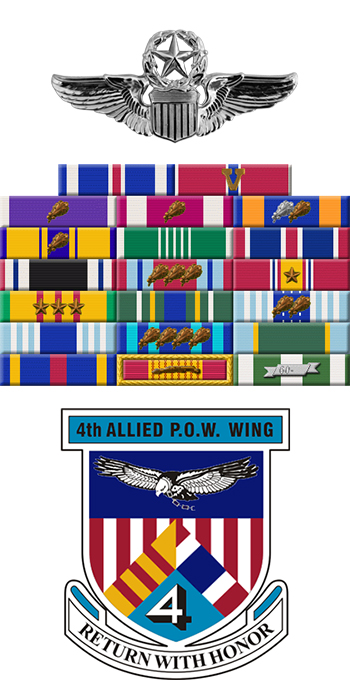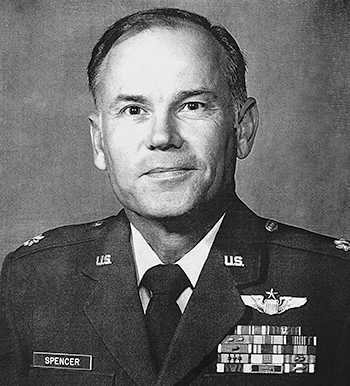
|
William A. "Bill" Spencer |
 |
|||
| Rank, Service | ||||
Lieutenant Colonel O-5, U.S. Air Force |
||||
| Veteran of: | ||||
|
||||
| Tribute: | ||||
Bill Spencer was born on August 4, 1943, in Brownsville, Texas. He graduated with a bachelor's degree in Mathematics from the University of Texas-Pan American in Edinburg, Texas, in 1967, and entered Officer Training School with the U.S. Air Force on February 7, 1967. Spencer was commissioned a 2d Lt in the U.S. Air Force at Lackland AFB, Texas, on April 19, 1967, and then attended Undergraduate Pilot Training at Randolph AFB, Texas, from May 1967 to May 1968. Lt Spencer completed Survival Training in July 1968, and F-4 Phantom II Operational Training in August 1968, before attending the F-4 Replacement Training Unit course with the 434th Tactical Fighter Squadron at George AFB, California, from September 1968 to February 1969. His first assignment was as an F-4 Pilot Systems Operator with the 523rd Tactical Fighter Squadron at Clark AB, Philippines, from April 1969 to January 1972, and during this time he attended F-4 Pilot Upgrade Training at MacDill AFB, Florida, in August 1971. Capt Spencer served as an F-4E pilot with the 469th Tactical Fighter Squadron at Korat Royal Thai AFB, Thailand, from January 1972 until he was forced to eject from his stricken aircraft over North Vietnam and was taken as a Prisoner of War on July 5, 1972. After spending 268 days in captivity, he was released during Operation Homecoming on March 29, 1973. Capt Spencer was briefly hospitalized to recover from his injuries at Wilford Hall Medical Center at Lackland AFB, Texas, and he then served as an F-4 pilot with the 59th Tactical Fighter Squadron and the 33rd Tactical Fighter Wing at Eglin AFB, California, from December 1973 until he left active duty and went into the Air Force Reserve on September 2, 1976. Major Spencer returned to active duty in the Air Force on September 18, 1981, and then served as an Air Liaison Officer with the U.S. Army at Fort Hood, Texas, from September 1981 to May 1982. He served as Commander of the 1st Cavalry Division Tactical Air Control Party at Fort Hood from May 1982 to January 1983, and then as an F-16 Fighting Falcon pilot with the 35th Tactical Fighter Squadron of the 8th Tactical Fighter Wing at Kunsan AB, South Korea, from January 1983 to January 1984. His next assignment was an F-16 Instructor Pilot with the 4th Tactical Fighter Squadron of the 388th Tactical Fighter Wing at Hill AFB, Utah, from February 1984 to November 1985, followed by service as Commander of the 2nd Armored Division Tactical Air Control Party at Fort Hood, Texas, from November 1985 to July 1990. Lt Col Spencer's final assignment was as an A-10 Thunderbolt II pilot, Assistant Director of Ground Operations, Assistant Deputy Commander for Air Operations, and then Assistant Deputy Commander for Operations with the 355th Fighter Wing at Davis-Monthan AFB, Arizona, from August 1990 until his retirement from the Air Force on January 1, 1992. |
||||
|
||||

